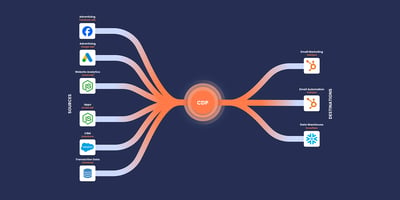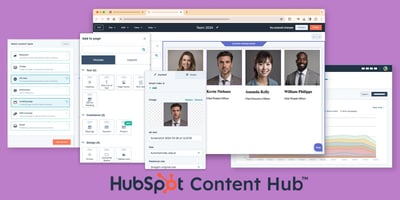HubSpot is the best CRM in the business, it really can do anything. Just think of a piece of software and HubSpot can likely integrate with it natively (a fancy term for “plug-and-play”).
But what happens when your client throws in a wild request? Such as “Can we sync Whatsapp conversations into HubSpot and trigger a task to be created if a lead says I’m interested?”
Usually, that's when you nod knowingly and say, “I’ll speak to our technical team and get back to you.”
This blog is here to bridge that gap so next time you’ll know exactly what’s possible with HubSpot API’s (without needing to be a master at code).
What is an API?
Apps need a way to talk to each other. API’s are the language that allows this conversation to take place.
Here’s a simple way to think about it:
- You (the customer) place an order (request)
- The waiter (API) takes your order to the kitchen (HubSpot)
- The kitchen prepares the meal (data), and the waiter brings it back to you (response)
That’s all an API does. It takes requests, fetches data, and delivers a response.
API’s Are Everywhere
Here are some everyday examples of API’s in action:
- Weather Apps: Your phone doesn’t magically know the weather, it calls an API from AccuWeather or Weather.com.
- Online Payments: When you make a purchase on Amazon, API’s are used to connect to a payment gateway such as PayPal.
- Google Maps and Uber: You know that little car that moves on your Uber app? That’s Uber talking to the Google Maps API in real time.
See? API’s really are everywhere, you just didn’t know what they were called.
What Can You Do with HubSpot’s API?
No technical jargon, just dreams!
- Sync live currency conversation rates into your deals from Yahoo Finance
- Integrate WhatsApp conversations with HubSpot tickets and workflows
- Customise lead scoring based on external data sources (e.g., social media)
- Sync order tracking from your store into HubSpot deals
- Connect any weird, custom software your business uses with HubSpot
There are no outlandish requests here. If you’ve ever wished HubSpot could do something custom, there’s probably an API for it.
What Have We Done with HubSpot APIs?
Over the years, we’ve done some amazing things with APIs in HubSpot. Some of my favourite include:
Messaging and Communication
- WhatsApp API Integration: Sync messages with HubSpot tickets
- Slack Integration: Send HubSpot deal updates to Slack in real time
CRM and Data Syncing
- AutoHub API: Push car dealership test drive data into HubSpot
- SAP and HubSpot Sync: Align HubSpot with SAP records automatically
- HubSpot to HubSpot Sync: Keep data in sync across multiple portals
Logistics and E-commerce
- Shipping Express Integration: Pull live order tracking into HubSpot
- SQL and AWS Databases: Sync external customer data with HubSpot contacts
- And that’s only scratching the surface. The possibilities are endless.
- Using HubSpot's API - Without Writing Code!
Even if you don’t write code, you can still leverage APIs with tools like:
- Zapier: Automated workflows between HubSpot and thousands of apps
- n8n: Connect HubSpot with other apps without coding.
- HubSpot’s Operations Hub: Use data sync features and custom-coded workflows.
- Google Sheets + API Connectors: Pull data into spreadsheets for reporting.
- HubSpot Marketplace: The official App store for HubSpot
Getting a Little More Technical… But Still Simple
Let’s start with API Authentication (The “Log In” of API’s). APIs need authentication, just like you need a password to log into a website. There are two ways HubSpot handles this:
- API Tokens: This is like a universal password that lets any system access HubSpot. It’s not ideal for security, which is why HubSpot is phasing it out.
- OAuth: This is like logging in with Google or Facebook. It’s secure and lets HubSpot control which data is shared.
Most integrations today use OAuth because it’s safer and more scalable than just sharing your API token.
Key HubSpot API Endpoints (And What They Do)
Think of API endpoints like sections of a menu at a restaurant - each one serves a specific function.
- Contacts API – Update, create, and fetch contact details
- Companies API – Manage company records
- Deals API – Track sales opportunities
- Tickets API – Manage customer service inquiries
- Custom Objects API – Create your own data structures in HubSpot (super powerful)
Each of these lets you push, pull, or modify data inside HubSpot from another app. There are a bunch more of them and HubSPot is constantly adding more object API endpoints.
Bringing It All Together: A Simple Example
Let’s say you run a car dealership and want test drives to be automatically logged into HubSpot from your website form. Here’s how API’s make it happen:
- A customer fills in a WhatApp chat flow on your website (Name, Car Model, Dealership, Test Drive Date)
- The website and WhatApp sends this data to HubSpot’s API
- HubSpot creates a new contact and deal automatically
- A sales rep gets a task notification in HubSpot
- The customer gets an automated WhatsApp reminder (via another API)
The result? No manual data entry. No forgotten leads. And a happy sales team!





